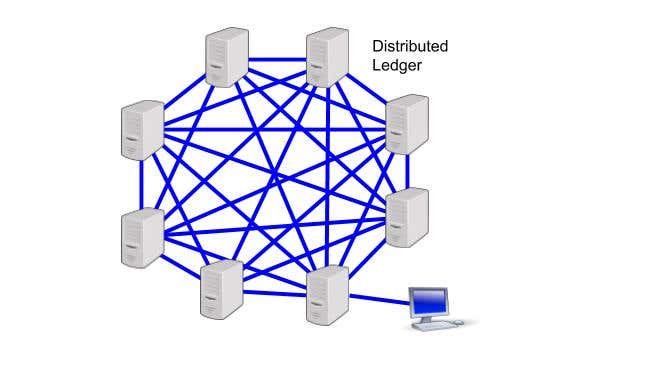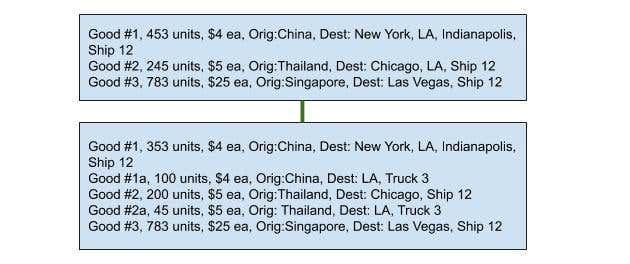Once you’re done reading this article, you’ll understand what a blockchain database is and why it represents an amazing new technology that could transform many industries.
What Is a Blockchain?
The foundational piece of a blockchain database is something called a blockchain. If you ask most tech bloggers out there, they’ll say “a blockchain is a distributed ledger”. But what’s a “distributed ledger”? Think of it like an identical data file that’s stored on a bunch of computers across the world all at the same time. That’s a distributed ledger. It’s decentralized – meaning the data isn’t stored on a single database sitting on a single server. Instead, the entire network of nodes (computers) holding the data makes up the “server” of sorts. The file stored in that ledger is provided with a cryptographic signature so that you, as a “participant”, can view the data it contains. However, there’s no central server that holds all of the information. This is why it’s called “decentralized”. A blockchain makes use of this ledger technology to store its own type of information made up of “blocks”. Every new “block” of data has to be confirmed and validated by every node on the network before it can get added. This is what makes the technology so secure. In other words, if a hacker who tries to attach data to the blockchain with the wrong cryptographic signature, the blockchain nodes will reject it. This is a blockchain. Historically, the technology has been used to store transactions of electronic currency (like Bitcoin). Transactions are secure and can’t be altered or manipulated. However, a blockchain database makes use of blockchain technology in a very different way.
What Is a Blockchain Database?
A blockchain database is the use of blockchain technology to store information. To visualize this, imagine how the shipping industry works today, versus how it could work using a blockchain database. A manifest contains a constantly updated log of:
Description of goodsConsignor and consigneeQuantity of goodsOrigin and destinationValue
Customs agents, trucking companies, and many other organizations that make up the entire shipping chain depend on the accuracy of these records. Unfortunately, throughout the world, there’s a history of fraud – where goods are “lost” and manifests are modified without authorization. Digitizing the process helps, but a centralized database is still susceptible to hacking and manipulation. The perfect solution is a blockchain database. This is because once a blockchain database is updated and verified as a new block in the “ledger”, it’s impossible to change or manipulate. Since every transaction is validated and verified as authenticated and approved, any attempt to manipulate the original quantity or value along the way will fail. Checks and balances must meet the strict authentication of every node in the blockchain. Incorrect “balances” aren’t allowed. Human error is no longer a valid excuse.
A “Chain” Database
When you think of the blockchain database in terms of a “chain”, it’s easy to picture what industries are best for the technology. Typically, it’s those areas where a record needs to be appended to with new, accurate, updated information. To see this in action, imagine a very simplified shipping manifest, with three goods. Note: this is a very simple example and looks nothing like actual data in a shipping blockchain database. This example is only used for illustrative purposes. The first “block” in the chain may contain the following data. At the first port, a new block is added to the chain with all transactions about offloaded goods cryptographically proven by the network nodes to be accurate in relation to the original block. If any of the transactions are invalid in relation to the first block, the new block won’t be accepted as a valid blockchain transaction. This means that human error can’t cause a “loss” of goods along the route. The entire blockchain serves as an accurate record of the route of shipment for all goods along the way. This process continues, and the blockchain database continues building additional blocks, until the entire shipping “transaction” is complete. There is an accurate record for anything that no one can alter.
Blockchain Database Applications
Is this technology useful in the real world? Walmart certainly thinks so. In 2018, the Canadian division of Walmart officially launched its own blockchain supply chain that tracked these kinds of shipping transactions for its 70 trucking company vendors. Walmart’s blockchain only contained a few dozen nodes to perform the cryptographic validation required as shipping trucks carried goods from one destination to another. One expert said that the system removes the likelihood of disputes between trucking companies when their records don’t match. Walmart isn’t the only company taking advantage of blockchain databases. All of the following applications have been launched in recent years.
In 2020, the U.S. Air Force is testing a blockchain database to share documents throughout the Department of Defense.In 2017, the nation of Estonia used the technology to protect public-sector data.In 2019, oil and gas firm Dietsmann launched a blockchain pilot with Modex to deploy its own blockchain projects.In 2018, the Food and Drug Administration explored using blockchain database technology to protect healthcare data.In 2019, Depository Trust & Clearing Corp, which holds $48 trillion in Wall Street investment assets, launched a blockchain database to handle its records for 50,000 accounts.
As you can see, blockchain databases aren’t just theoretical. They are being applied to very real real world applications that require trusted transactions. It may very well be that in the future, any transaction in the world that requires the highest levels of security will be handled by some type of blockchain database technology.








